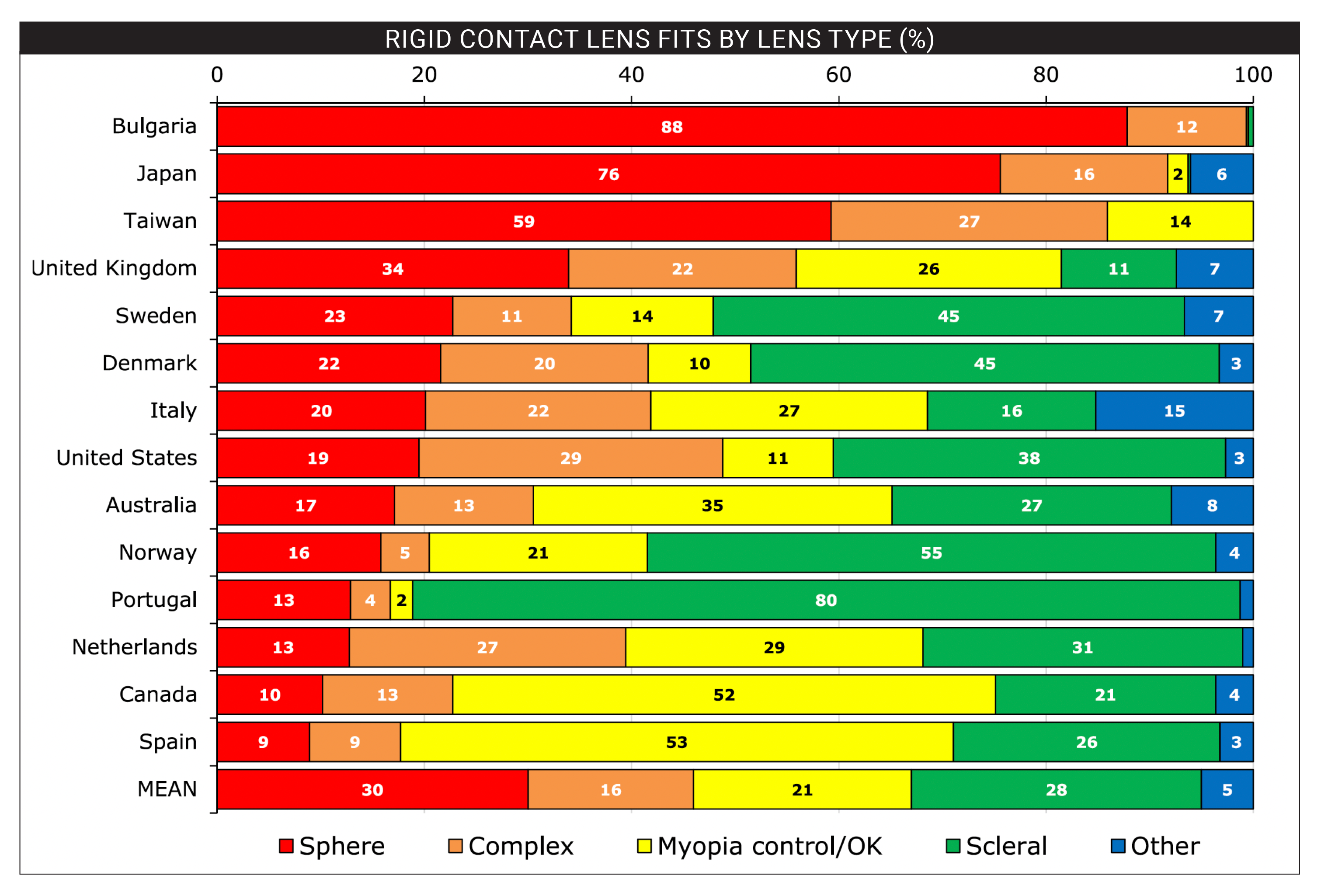Despite advancements in the soft contact lens field, rigid contact lenses still play a major role in myopia control and in refractive correction for patients requiring a custom fit. A recent study published in Contact Lens & Anterior Eye extended previous reports on contact lens prescribing trends worldwide.
An annual contact lens prescribing survey was sent to eyecare practitioners in up to 71 countries between 2000 and 2023. Data relating to 342,500 fits undertaken in 20 countries returning reliable longitudinal data were analyzed with respect to rigid lens fitting. The authors found a renewed interest in rigid lens fitting due to a repurposing of rigid lenses, with the growth of scleral/corneoscleral and myopia control/orthokeratology (ortho-K) lens fits essentially replacing conventional spherical corneal lens fits.
 |
| This chart from the study shows the proportion of spherical, complex (including hybrid, toric, multifocal and monovision), orthokeratology and scleral (including corneoscleral) designs used for rigid lens fits between 2019 and 2023. Photo: Efron N, et al. Cont Lens Ant Eye. June 24, 2024. Click image to enlarge. |
Overall, rigid lens prescribing increased slightly over time, from 14.2% of lens fits in 2000 to 15.2% in 2023. However, post-hoc analysis shows that the change over time is best described as a decline between 2000 and 2012 followed by a steady increase subsequently. The proportion of rigid lenses fitted with high Dk materials over the past 12 years increased from 36% between 2007 and 2011 to 67% between 2019 and 2023.
“This trend toward fitted lenses fabricated from high Dk materials is consistent with trends in the soft lens domain, whereby high Dk silicone-hydrogel materials currently constitute the majority of lens fits,” the researchers explained in their paper. “High Dk materials offer the advantage of maximizing corneal oxygen availability during lens wear, thus optimizing corneal health. This is especially relevant for rigid lenses used for overnight ortho-K and scleral lenses that have greater thickness and minimal tear exchange. Mid-Dk and low Dk rigid corneal lenses have the advantage of a higher modulus (i.e., more stiff, offering durability and better masking of astigmatism) and greater scratch resistance, which may be why a significant minority of such lenses are still being fitted.”
There were significant differences in rigid lens prescribing between countries (see chart). Possible reasons include:
- the balance of professional contact lens prescribers (optometrists, ophthalmologists, opticians) in different countries
- longstanding traditions of rigid lens fitting in some nations
- local availability of rigid lens manufacturers
- influence of opinion leaders in various regions
- differences in the prevalence of myopia driving ortko-K fits in certain regions, especially in Asian nations
- differences in the affordability/availability of corneal topographers
A small difference between male (12.7%) and female (12.0%) patients was noted, although not clinically meaningful. Rigid lens wearers were older than soft lens wearers (38.7 vs. 31.3 years, respectively). Possible reasons explaining this are the presumed ‘loyalty’ of successful rigid lens wearers who, once successfully adapted, are happy to keep wearing this lens type and are less likely to drop out of lens wear and the availability of better rigid lens designs fueling increased bifocal fitting to presbyopes, the authors explained.
“It would seem that these factors outweigh a potential cause of a decrease in the age of rigid lens wearers, namely, growth in use of designs to manage myopia progression (i.e., ortho-K lenses), which are likely fit to a younger age group,” the authors noted.
Analysis of 5,994 rigid lens fits prescribed currently (2019 to 2023) were categorized as: corneal sphere (30%); scleral and corneoscleral (28%); corneal myopia control/orthokeratology (21%); and complex corneal fit, including toric, multifocal and monovision (16%).
Between 2007 and 2011, spherical lenses represented 55% of rigid lens fits, whereas ortho-K lenses and scleral lenses represented only 11.5% and <9%, respectively, and myopia control was in its infancy, with negligible fits. However, between 2019 and 2023, spherical lenses represent only 30% of rigid lens fits, whereas scleral lenses and myopia control/orthokeratology lenses constitute 28% and 21% of rigid lens fits, respectively.
“The renewed interest in scleral lenses seems to be related to the development of lens materials and designs that afford greater comfort, and a more stable refractive correction,” the authors concluded in their paper. “In parallel with this, the myopia epidemic has energized the development of both rigid and soft contact lenses capable of slowing myopia progression, and orthokeratology lenses have been demonstrated to have efficacy in this regard.”
A comparable report from the same group delves into trends in soft lens wear. You can read our report on that paper here.
Efron N, Morgan PB, Woods CA, et al. International trends in rigid contact lens prescribing (2000-2023): an update. Cont Lens Ant Eye. June 24, 2024. [Epub ahed of print.] |

